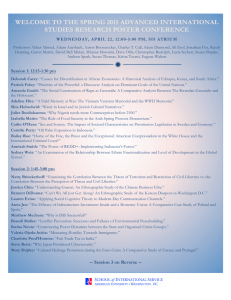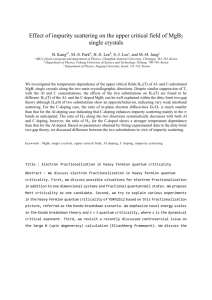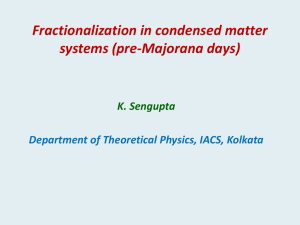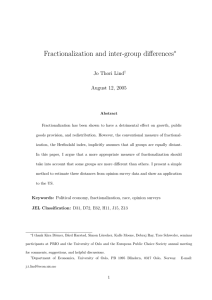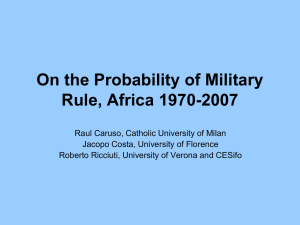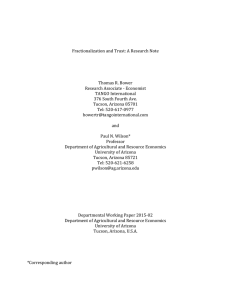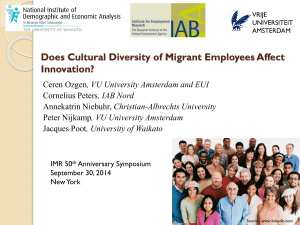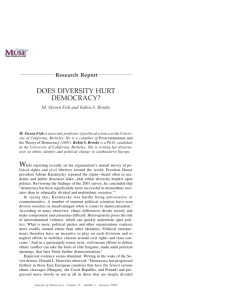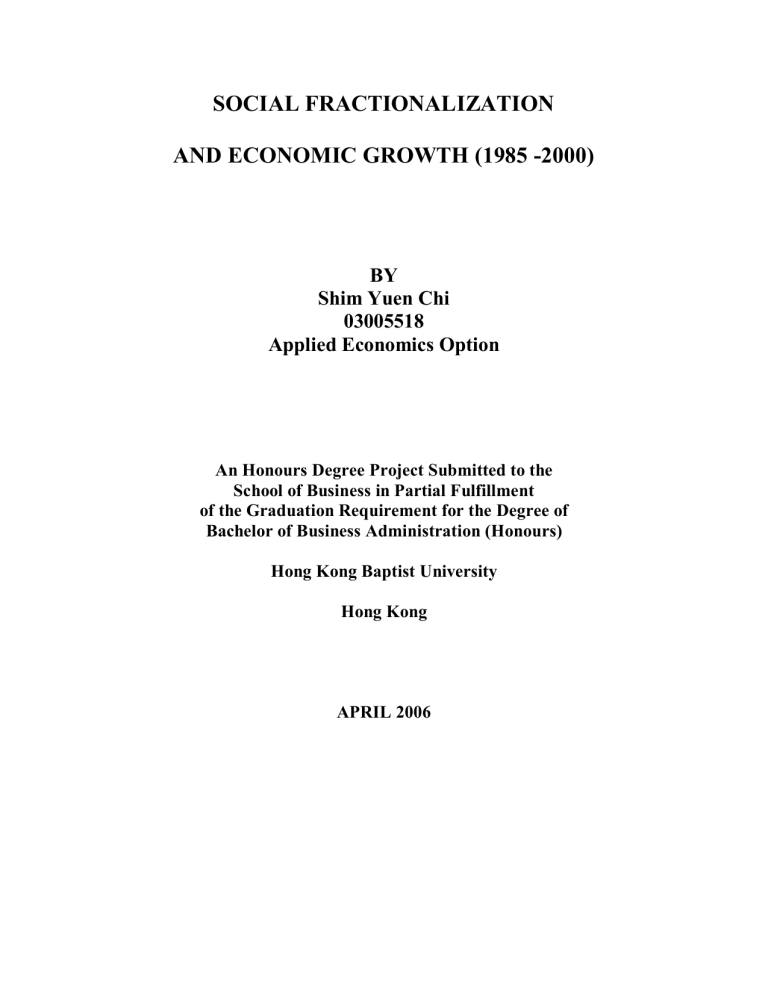
SOCIAL FRACTIONALIZATION AND ECONOMIC GROWTH (1985 -2000) BY Shim Yuen Chi 03005518 Applied Economics Option An Honours Degree Project Submitted to the School of Business in Partial Fulfillment of the Graduation Requirement for the Degree of Bachelor of Business Administration (Honours) Hong Kong Baptist University Hong Kong APRIL 2006 Acknowledgement I would like to express my sincere thanks to my supervisor Dr. Mo Pak Hung for his helpful comments and suggestions. Dr Mo has given me great flexibility on choosing topic and research methods. His valuable advices guided me to overcome many obstacles during the learning process. Furthermore, I wish to thank all parties that give me supports in completing this paper. i Abstract This paper employs the framework developed by Dr. Mo to estimate the role of social fractionalization in economic growth. From the empirical result, with 1% increase in the social fractionalization index (i.e. change from complete homogeneity to complete heterogeneity), the real GDP growth rate reduces by 2.11 %.The impacts of social fractionalization on developing and developed countries are investigated. Social fractionalization may not be harmful to developed countries while the effect on developing countries is more adverse. With 1 % increase in the social fractionalization index, the real GDP growth rate drops by 2.95 %. And the direct and indirect effect of it on developing countries is reported. The direct effect contributes 69.3 % to the overall effect. Among the transmission channels, the investment channel, which accounts for 11.0 %, and political instability channel accounts for 5.1 %. ii Table of Contents Acknowledgement.........................................................................................................i Abstract…………………………………………………………………………………ii Table of Contents……………………………………………………………………...iii 1. Introduction.................................................................................................................1 2. Literature Review......................................................................................................3 3. Methodology...............................................................................................................6 4. Data Description........................................................................................................8 5. Empirical Analysis...................................................................................................12 6. The Effect on Developing and Developed countries….............................. …16 7. The Direct and Indirect effect on Developing countries................................22 8. Limitations.................................................................................................................26 9. Conclusion..................................................................................................................27. References Appendix iii 1. Introduction In the field of economic development, economic growth is one of the most important indicators of economic development. From years of researches made by the economists, there are many factors affecting economic growth. These factors include investment, government consumption, political instability, human capital, technological change and openness. There are numbers of papers find out that government size (Mo 2004) and political instability (Anthony Annett 2001) are both negatively related to the economic growth. While investment and technology improvement has long been regarded as an important factor contributing to economic growth. What are the causes leading to higher political instability and lower investment? Social fractionalization (or social diversity) may be the answer. In 1960s, a team of Soviet ethnographers carried out a research and published as Atlas Narodov Mira. Their list of “ethnolingistic” groups and population figures has been employed by political scientists, socicologists, and economists to produce the cross-national estimates of ethnic fractionalization, such as Easterly and Levine’s work on economic growth have employed this measure. James D. Fearon has done the similar effort of the Soviet ethnographers to provide the more updated statistics of ethnic and cultural fractionalization as the average of 1980s and 1990s. 1 The basic idea of how social fractionalization hinders economic growth is that when there is higher number of groups with different racial, languages, value and belief, it is more difficult in coordination and communication, these cost could be a high transaction cost. This would also rise the uncertainty and instability, thus lower investment. In the game theory, when the number of competitors rise, the harder for the society to achieve the cooperative Nash equilibrium. Therefore, social fractionalization is harmful to economic growth. The objective of this paper is to employ the economic growth framework developed by Dr. Mo and the data of James D. Fearon to estimate the comprehensive effect of social fractionalization on economic growth. The result on developed and developing countries are reported separately. Finally, decomposition is made to investigate the direct and indirect effect through transmission channels. The paper is organized as follows. Literature review about social fractionalization is shown in the next section. In section 3, we introduce the analytical framework of this paper. The data and descriptive statistics are shown in section 4. Section 5 is the report of the regression results. In section 6, the different results on developing and developed countries are reported. Section 7 shows the effect of social fractionalization on different transmission variables .Section 8 shows the limitations of this paper. The last section is the conclusion. 2 2. Literature Review The idea of how social fractionalization (along ethnolinguistic and religious dimensions) is related to political instability and government consumption was explored by Anthony Annett (2001). The empirical evidence showed that greater fractionalization, proxying for the degree of conflict in society, leads to political instability, which in turn leads to higher government consumption aimed at placating the opposition. But our main concern is how the above relations affect economic growth. Easterly and Levine (1997) concluded the direct effect of social fractionalization on economic growth. In a cross-country setting, the results have shown that per capita GDP growth is inversely related to ethnolinguistic fractionalization in a large sample of countries. In particular, they argued that much of Africa’s growth failure is due to ethnic conflict, partly as a result of absurd borders left by former colonizers. Marta Reynal-Querol and José G. Montalvo (2005) examined the harmfulness of the existence of different religious groups on the process of economic growth of a country. The study on the relation between social conflicts and growth one of the most important determinants is religious diversity. The most important religious tensions in the world can be found in Lebanon and Israel, where there are conflicts among religious communities; in Malaysia with tension between Christians and Muslims; in India, between Hindus and Muslims. 3 The indirect effects of social fractionalization on economic growth are also examined by different economists. Higher social fractionalization leads to higher political instability, the negative effect of political instability on economic outcomes were shown by sizable literatures. Barro (1991, 1996) finds that political violence leads to lower growth in a cross section of countries. Alesina and Perotti (1996) take this approach, arguing that the disorder created by this form of political instability adversely affects productivity and the return to investment The impact of social fractionalization on government activities and quality of institutions was explained by Canning and Fay (1993) and Mauro(1995). La Porta et al. (1999), in a broad empirical study of the determinants of the quality of government, suggest that ethnic fractionalization matters, even though variables related to legal origins may be more important. A large literature on US localities show that in more ethnically fragmented communities, public goods provision is less efficient, participation in social activities and trust is lower, and economic success, measured by growth of city sizes, is inferior. Mauro (1995) further examine the relation between social fractionalization and long-run growth. He argues that ethnic conflict may lead to political instability and, in extreme cases to civil war. Moreover, he also argues that ethnolinguistic fragmentation may reduce investment not only by increasing corruption and political instability, but also via a direct channel. For example, it might slow down the discussion of ideas and technological innovations within the country. 4 However Many authors have found, social fractionalization is not significant in the explanation of civil wars and other kinds of conflicts. These results have led many authors to disregard ethnicity as a source of conflict and civil wars. Fearon and David D. Laitin (2003) and Collier and Hoeffler (1998) find that neither ethnic fractionalization nor religious fractionalization have any statistically significant effect on the probability of civil wars. 5 3. Analytical Framework In this project, I use a framework which is developed in Mo (2000) to investigate the effect of inflation on the economic growth. This framework starts with the input and output relationship. It is characterized by the general production function. 1) Y= T f (K, L) Where Y is the total output level, T is total factor productivity, K is the capital stock and L is the labor stock. Then, total differentiate Y: Divide (2) by Y, it becomes: Simplify the equation: Where GR represents the real GDP growth rate, γis the growth rate of real GDP and total factor productivity respectively, IY is the investment output ratio and dLL is the growth rate of labor. Base on prior works in the literature, Levine and Renelt (1992), the share of investment in GDP, the rate of population growth, the initial level of real GDP, and a proxy for 6 human capital are the variables that affect the growth. The share of investment in GDP and the rate of population growth are growth component, which is related to the factor availability. The initial level of real GDP and the proxy for human capital are development component, which is related to the effect of social and technological changes. Include all these variables in the growth model, and further define the rate of productivity growth as: (5) γ=γ( SOCF, y0, HUMAN) Therefore, the growth model becomes, (6) GR = F(γ(SOCF, y0, HUMAN,), IY(γ), dLL) Where SOCF is the index for the level of social fractionalization, y0 is the initial GDP per capita, HUMAN is a proxy of human capital stock. 7 4. Data Description There are 138 countries in the sample in order to have the cross nation’s analysis and the country list follows panel data set assembled by Robert Barro and Jong-Wha Lee. The fifteen-year period chosen is from 1985 to 2000 as to make the data as up-to-date as possible. Another reason for choosing this period is because the social fractionalization index is the average for the 1980s to 1990s, therefore the estimation is more accurate and meaningful. Most of the data are extracted from the Penn World Table, including the real gross domestic product per capita and total population from 1985 to 2000. (Average growth rate is derived) The ratio of investment and government consumption over real gross domestic product are also obtained from this source. The data are divided as an averaged five years’ sub-period, i.e. there are 3 five-year-averaged observations for a variable in the period 1985-2000 so as to smooth over some cyclical features of the data. Political instability is also one of the variables that shows the indirect impact of social fractionalization on economic growth. Political instability is defined as average of the number of assassinations per million population per year and the number of revolutions per year over the period. This data is obtained from Databanks International. The growth rate of population is used as a proxy for the growth rate of labor. Although 8 the growth rate of population is different from the growth rate of labor and might have different effects to the GDP growth, the quality of the data on population growth is better. It is because different countries have different definitions of labor and the measurements of labor growth are also not identical. It makes the labor growth rates become incomparable. Therefore, it is common for researchers to use population growth as a proxy. The average schooling years in the total population over age 25 is used as a proxy for human capital stock. This data is obtained from Barro and Lee dataset. The variable which this paper is interested in is social fractionalization. The definition of the index followed Annett Anthony to measure the social fractionalization along ethnical (racial), cultural (linguistic) and religious diversity. The indices developed in this paper are defined as follows. Formally, it can be calculated from the following formula: (7) N is the total population and ni is the number of people belonging to the i-th group. Therefore, the index of social fractionalization is defined as the average of ethnic, cultural and religious fractionalization: 9 (8) Social Fractionalization = (Ethnic Fractionalization + Cultural Fractionalization + Religious Fractionalization) / 3 It measures the probability that two randomly selected individuals in a country will belong to different ethnolinguistic and religious groups. This variable ranges from 0 to 1. The larger number of ethnolinguistic and religious groups and the closer the sizes of the groups are, the larger the index is. For instance, when there is only one ethnic group, the index equals to 0. The index equals to 1 when there are infinite number of ethnic groups. When there are only two ethnic groups with the same size, the index equals to 0.5. The ethnic and cultural fractionalization index are obtained James D. Fearon’s (2003) Ethnic and Cultural Diversity by Country, which Ethnic Fractionalization present a list of 822 ethnic groups in 160 countries that made up at least 1 percent of the country population, while Cultural Fractionalization used structural relationships between languages as a proxy for cultural similarity. Religious Fractionalization used here are constructed by Alesina et al.(2002), basing on data from the Encyclopedia Britannica, 2001. The index covered 294 different religions in 215 countries. The correlation coefficients and descriptive statistics for the major variables are summarized in Table 1.The variables are defined in the note to the table and the original acronyms and sources of data are summarized in Appendix. 10 Table 1 Correlation coefficients and descriptive statistics GR SOCF y0 POPG IY GOV GR 1 SOCF -0.07963 1 y0 -0.09791 -0.16951 1 POPG 0.111441 0.271577 -0.60408 1 IY 0.100991 -0.32096 0.585027 -0.44623 1 GOV -0.03543 0.264972 -0.5386 0.354201 -0.30386 1 HUM -0.02458 -0.21679 0.824258 -0.64865 0.616308 -0.43229 INSTAB -0.03124 -0.06289 -0.18592 0.144221 -0.20454 0.041455 Mean Median HUM INSTAB 1 -0.16462 1 0.060558 0.384484 5334.544 0.016806 16.04713 18.46128 5.759288 0.28677 0.059103 0.3852 3604.682 0.018129 15.5419 16.80648 5.521 0.083333 Note. GR = growth rate of real GDP, SOCF = index for social fractionalization, y0 = real GDP per capita at 1985, POPG = population growth rate, IY = ratio of private investment to real GDP, GOV = share of government consumption in real GDP, HUM = average schooling years in the total population over age 25, INSTAB = index for political instability. 11 5. Empirical Analysis Pooled Least Squares was used for regressions to estimate the effect of social fractionalization on the economic growth. The regressions reported in Table 2 reveals the sensitivity of the estimated effects. 12 TABLE 2 The effect of Social Fractionalization on the Growth Rate (World dataset) Estimation: B1 Independent variables SOCF GR B2 B3 Dependent Variables GR GR B4 GR -0.043117 (-4.41) -0.033597 (-3.37) -0.043043 (-4.39) -0.031099 (-2.82) y0 -1.597826 (-0.32) -9.730966 (-1.80) -2.051331 (-0.38) -1.616718 (-2.12) POPG 0.273134 (1.28) 0.416716 (1.96) 0.319025 (1.48) 0.521982 (2.18) IY 0.001047 (3.55) GOV -0.000075 (-0.36) HUM 0.003167 (2.45) INSTAB CONSTANT 0.073763 (10.61) 0.055309 (6.54) 0.074506 (8.73) 0.053495 (5.35) R2 0.06 0.11 0.07 0.07 348 336 336 284 P P No. of obs. Dummy 1 0.003407 (0.75) 0.004186 (0.93) 0.004691 (1.01) 0.004837 (0.96) Dummy 2 -0.005819 (-1.28) -0.006537 (-1.45) -0.006156 (-1.34) -0.003624 (-0.72) 13 TABLE 2(Con’t) The effect of Social Fractionalization on the Growth Rate (World dataset) Estimation: B5 Independent variables SOCF GR B6 B7 Dependent Variables GR GR B8 GR -0.040256 (-3.92) -0.019830 (-1.78) -0.027476 (-2.42) -0.021051 (-1.81) y0 -2.699334 (-0.51) -2.437331 (-3.05) -2.201242 (-2.51) -0.000003 (-2.86) POPG 0.325031 (1.43) 0.594354 (2.53) 0.609207 (2.35) 0.605345 (2.36) IY 0.000877 (2.69) 0.000794 (2.30) GOV -0.000535 (-2.08) -0.000473 (-1.62) -0.000498 (-1.72) HUM 0.002167 (1.63) 0.003130 (2.28) 0.002272 (1.61) -0.003741 (-0.97) -0.002418 (-0.63) INSTAB -0.007112 (-2.05) CONSTANT 0.075378 (10.34) 0.053584 (4.80) 0.064841 (5.57) 0.056568 (4.68) R2 0.07 0.11 0.08 0.10 323 275 257 257 P P No. of obs. Dummy 1 0.000762 (0.16) 0.007133 (1.41) 0.004746 (0.89) 0.004368 (0.83) Dummy 2 -0.006900 (-1.46) -0.003862 (-0.78) -0.005059 (-0.97) -0.005404 (-1.04) Note: Dummy 1 is the dummy for period 1985-1989 (i.e. 1985-1989=1, 1990-1994:0, 1994-2000=0) Dummy 2 is the dummy for period 1990-1994 14 In table 2, estimation B1 indicates that social fractionalization has a significant negative effect on the real GDP growth rate when all the transmission channels are excluded in the regression. Estimations B2 to B5 show the effects of social fractionalization to the real GDP growth rate when the possible transmission channels, which are the share of investment, share of government consumption ,human capital stock and political instability, are added to the regression independently. As expected, the magnitude and significant levels of the SOCF coefficient in B2 to B5 are smaller that in B1. However, the coefficient is still significant at the conventional confidence interval. The magnitude and the significant level of the SOCF coefficient are -0.021051 and -1.81 in estimation B8 when all the possible transmission channels are included. It showed that in the world sample, social fractionalization only has weak significant impact on economic growth. In the next section, this paper will investigate in whether the effects of social fractionalization on economic growth differ in developing and developed countries. 15 6. The Effect on Developing and Developed countries Two regressions are run separately for the developing and developed countries. The definition of developing countries followed the World Bank’s classification system. Developing countries are those with low-, lower-middle, or upper-middle incomes, while developed countries are those high-income OECD countries and other high-income countries. Table 3 shows the impacts of social fractionalization on developing countries. Table 4 shows the impacts of social fractionalization on developed countries. 16 Table 3 The effect of Social Fractionalization on Growth Rate (Developing countries dataset) Estimation: B1 Independent variables SOCF GR B2 B3 Dependent Variables GR GR B4 GR -0.042638 (-4.37) -0.039369 (-4.03) -0.043551 (-4.56) -0.034664 (-2.90) y0 -7.033960 (-0.85) -9.701227 (-1.21) -7.289654 (-0.87) -1.581667 (-1.36) POPG 0.036042 (0.16) 0.149800 (0.66) 0.065464 (0.29) 0.336886 (1.22) IY 0.000609 (1.75) GOV 0.000030 (0.15) HUM 0.001642 (1.10) INSTAB CONSTANT 0.081306 (10.80) 0.070713 (7.18) 0.080580 (8.78) 0.067650 (5.56) R2 0.21 0.21 0.23 0.18 258 246 246 197 P P No. of obs. Dummy 1 -0.002944 (-0.50) -0.001807 (-0.30) -0.001783 (-0.29) -0.004796 (-0.67) Dummy 2 -0.006816 (-1.09) -0.007562 (-1.17) -0.007442 (-1.14) -0.004812 (-0.68) 17 Table 3 (Con’t) The effect of Social Fractionalization on Growth Rate (Developing countries dataset) Estimation: B5 Independent variables SOCF GR B6 B7 Dependent Variables GR GR B8 GR -0.040701 (-3.90) -0.028211 (-2.43) -0.032648 (-2.75) -0.029533 (-2.46) y0 -6.433091 (-0.76) -2.178531 (-1.89) -2.175321 (-1.84) -2.160107 (-1.85) POPG 0.061788 (0.26) 0.405446 (1.50) 0.389754 (1.31) 0.406225 (1.38) IY 0.000574 (1.36) 0.000484 (1.12 ) GOV -0.000472 (-1.73) -0.000395 (-1.27) -0.000436 (-1.42) HUM 0.001325 (0.87) 0.002035 (1.35) 0.001479 (0.93) -0.003185 (-0.76) -0.002703 (-0.64) INSTAB -0.006316 (-1.75) CONSTANT 0.082728 (10.49) 0.069226 (5.24) 0.076029 (5.50) 0.071278 (4.97) R2 0.19 0.20 0.23 0.22 245 188 182 182 P P No. of obs. Dummy 1 -0.004125 (-0.68) -0.001920 (-0.26) -0.002649 (-0.36) -0.002613 (-0.35) Dummy 2 -0.007390 (-1.15) -0.005071 (-0.70) -0.005833 (-0.78) -0.005937 (-0.79) 18 Table 4 The effect of Social Fractionalization on Growth Rate (Developed countries dataset) Estimation: B1 Independent variables SOCF GR B2 B3 Dependent Variables GR GR B4 GR -0.030965 (-2.01) -0.021663 (-1.35) -0.030756 (-1.99) -0.016269 (-1.02) y0 -2.355546 (-3.15) -2.572652 (-3.44) -2.451587 (-3.22) -3.361348 (-3.64) POPG 1.672536 (4.65) 1.339061 (3.35) 1.714516 (4.69) 1.352706 (3.69) IY 0.000751 (1.82) GOV -0.000285 (-0.70) HUM 0.001470 (0.82) INSTAB CONSTANT 0.079750 (7.62) 0.064132 (4.78) 0.083148 (7.20) 0.074269 (5.32) R2 0.44 0.46 0.44 0.46 90 90 90 87 P P No. of obs. Dummy 1 0.024098 (4.31) 0.023129 (4.17) 0.025460 (4.29) 0.024277 (4.29) Dummy 2 -0.004834 (-0.86) -0.004378 (-0.79) -0.004466 (-0.79) -0.003661 (-0.66) 19 Table 4 (Con’t) The effect of Social Fractionalization on Growth Rate (Developed countries dataset) Estimation: B5 Independent variables SOCF GR B6 B7 Dependent Variables GR GR B8 GR -0.028515 (-1.91) 0.000234 (0.01) -0.011192 (-0.72) 0.005007 (0.30) y0 -2.429079 (-3.00) -3.730502 (-4.09) -3.219158 (-2.74) -4.702251 (-3.62) POPG 1.790260 (5.04) 0.820692 (1.93) 1.473270 (3.92) 0.678439 (1.37) IY 0.001070 (2.54) 0.001175 (2.36) GOV 0.000025 (0.06) -0.000097 (-0.24) 0.000128 (0.32) HUM 0.001329 (0.76) 0.000043 (0.02) 0.001807 (0.86) -0.015490 (-2.77) -0.011622 (-2.05) INSTAB -0.014724 (-2.55) CONSTANT 0.083654 (7.55) 0.052907 (3.06) 0.088927 (6.14) 0.059460 (3.17) R2 0.48 0.50 0.51 0.54 78 87 85 75 P P No. of obs. Dummy 1 0.018176 (3.23) 0.022617 (3.85) 0.017255 (2.85) 0.016032 (2.72) Dummy 2 -0.008231 (-1.45) -0.002945 (-0.54) -0.007260 (-1.29) -0.005612 (-1.02) 20 There are two interesting points to notice. First, comparing with equation B8 in Table 2 and Table 3, the coefficient and significant level of SOCF in developing countries are both higher. It showed that the impact of social fractionalization is more harmful in affecting the developing countries than the overall world. The result may confirm to Ines Lindner and Holger Strulik (2004) ‘s model that predicts the countries with low social capability through low initial endowment of means of mass communication and insecure property rights, that is the developing countries suffer more from sufficiently polarized society. Therefore, further investigation in the transmission channels in developing countries will be examined in the next section. Second, looking at the result of equation B8 in Table 4, the coefficient of SOCF in developed countries dataset is positive rather than negative shown in Table 2 and Table 3. Although the significant level is low, it showed that social fractionalization may has positive impact on economic growth in developed countries. The reasons behind are complicated and further research is needed. One of the reasons is that the developed countries could be a proxy for better government quality, legal system, higher and more equal education level and income, higher freedom and more secured property rights…etc, these factors may diminish the adverse effect of social fractionalization on economic growth. While better coordination make people who belong to different groups are able to cooperate, and make the domestic competition become productive, so social fractionalization may be not harmful in these countries. 21 7. The Direct and Indirect Effect 7.1 Direct impact Refer to the estimation B1 and B8 in Table 5, the direct effect of social fractionalization accounts for about 69.3% of the total effect. Direct impact (a) -0.029533 Table 5 Total effect (b) -0.042638 (a) / (b) 0.693 7.2 Indirect effect Two transmission channels are chosen here to investigate how social fractionalization affects economic growth through these channels. These channels are investment channel and political instability channel. 7.2a Investment channel When social fractionalization is high, implies an increase in uncertainty and instability , therefore, could lead to a reduction of the investment rate The potential ethnic conflicts has a negative impact on investment and, indirectly, on growth. Second, ethnic diversity may generate a high level of corruption which, in turn, could deter investment. Furthermore, in rent-seeking models, the resources spent by each groups in order to 22 obtain political influence (e.g. time, labor, etc.) can be considered as a social cost that has a negative effect on economic growth because it implies a non-productive usage of these inputs. This would clearly reduce the investment in the productive sector (Montalvo and Reynal-Querol, 2003). If the growth rate of real GDP depends on the share of investment and the share of investment is affected by social fractionalization, the effect of social fractionalization on the real GDP growth rate can be decomposed as: (9) ∂GR ∂GR ∂IY dGR ) +( = ∂IY ∂SOCF dSOCF ∂SOCF To find out the effect of ethnicity to share of investment, we estimate the effect of ethnicity on share of investment together with the non-transmission variables by: (10) IY = -7.722503 SOCF + 0.000740 y0 - 24.814523 POPG -0.190483 DUMMY1 (-3.28) (3.82) (-0.86) (-0.32) + 0.086210 DUMMY2 + 14.419003 (0.20 ) (9.84 ) R2 = 0.542 P P No. of observations = 82 Equation (10) indicates that SOCF has a negative effect on the share of investment. The direct effect of social fractionalization on the real GDP growth rate is shown in the coefficient of SOCF in estimation B2, while that in B1 incorporates the direct effect and the indirect effect from the share of investment. Base on equation (10), regression B1 and B2, we can calculate the role of the share of 23 investment by using equation (9). The results are reported in Table 6. We can see that about 11% of the growth rate reduction is due to the investment channel. Direct effect -0.039369 Table 6 Investment channel (a) 0.000609 *(-7.722503) =-0.004702 Total effect (b) -0.042638 (a) / (b) 0.110 <-0.039369+(a)>= -0.044072 7.2b Political instability channel Some researchers show that religious and ethnic polarization have a negative effect on growth through the increase in the probability of civil wars (Montalvo and Reynal-Querol, 2000). Although we do not include the effect of civil wars in our definition of political instability, it is reasonable that social fractionalization make the overall political environment more unstable. While higher political instability and social disruption that will lead the government and society to trade off private rents in order to devote resources toward the alleviation of this instability. (Anothy Anetty). If the real GDP growth rate is affected by political instability, we can decompose the effect of ethnicity to political instability by equation (13): (11) dGR ∂GR ∂GR ∂INSTAB = ) +( dSOCF ∂SOCF ∂INSTAB ∂SOCF We estimate the effect of ethnicity on political instability by following regression: 24 (12) INSTAB = 0.341912 SOCF + 0.000024 y0 + 5.129235 POPG (3.15) (2.69) (2.42) + 0.028780 DUMMY1+ 0.102362 DUMMY2 - 0.097381 (0.66) (2.38) (-1.36) R2=0.18 P P No. of observations = 82 Equation (12) indicates that ethnicity has a positive effect on the political instability. The direct effect of ethnicity on the real GDP growth rate is shown in the coefficient of SOCF in estimation B5, while that in B1 incorporates the direct effect and the indirect effect from the political instability channel. Base on equation (12), regression B1 and B5, we can calculate the role of the share of government consumption by using equation (11). The results are reported in Table 7. It indicates that about 5.1 % of the growth rate reduction is due to the political instability channel Direct effect -0.040701 Table 7 Political instability channel (a) -0.006316 *0.341912 =-0.002160 Total effect (b) (a) / (b) -0.042638 0.051 <-0.040701+(a)>= -0.042860 U 25 8. Limitations In this paper, the index for social fractionalization is obtained from 2 different sources. Due to the different in research methods and definition of variables, the accuracy of the index is affected. The definition of social fractionalization followed James D Fearon’s one. It is assumed that ethnic, languages and religious are the only 3 aspects of fractionalization and they share the equal weights and importance. The index may not able to reflect the full degree of fractionalization in a society. One example is in Hong Kong, most people are in same ethnic and have the same mother language, but the society still can be fractionalization by people holding different value or opinion towards difficult issues, e.g. the voting system. These difference could create political instability and harm to economic growth. The social fractionalization may be higher than the index mentioned. Another critique is about the index of political instability. The index takes the average of revolution and assassination per year as a proxy. Although it is widely used, it still faces the problem as the index of fractionalization mentioned above. Especially in this topic, the social fractionalization may not directly lead to revolution or assassination, but raise the probability of civil war, riots and other domestic unproductive competitions. The result in the political instability transmission channels is therefore affected and underestimated. 26 9. Conclusion This paper employs the framework developed by Dr. Mo to estimate the role of social fractionalization in economic growth. The impacts of social fractionalization on developing and developed countries are investigated. And the direct and indirect effect of it on developing countries is reported. In the world dataset, with 1% increase in the social fractionalization index (i.e. change from complete homogeneity to complete heterogeneity), the real GDP growth rate reduces by 2.1 %. And this paper discovers that social fractionalization may has different result on developing and developed countries. Social fractionalization may not be harmful to developed countries while the effect on developing countries is more adverse. With 1 % increase in the social fractionalization index, the real GDP growth rate drops by 2.95 %. The direct effect contributes 69.3 % to the overall effect. Among the transmission channels, the investment channel, which accounts for 11 %, and political instability channel accounts for 5.1 %. These two channels are what we are interested in our model. However, it does not mean that social fractionalization is solely related to these two channels. For other possible channels such as openness, communication, technology, level of democracy that other papers employed, are not included in this paper. 27 References Alberto Alesina, Arnaud Devleeschauwer, William Easterly, Sergio Kurlat and Romain Wacziarg, (2002), “Fractionalization”, Harvard Institute of Economic Research, Discussion Paper Number 1959 Annett Anthony, (2001), “Social Fractionalization, Political Instability, and the Size of Government”, IMF Staff Papers, Vol. 48, No. 3, pp. 561-592 Barro, R. (1991), "Economic Growth in a Cross Section of Countries," Quarterly Journal of Economics, CVI, 407-43. Barro, R. (1996), "Determinants of Economic Growth: A Cross-Country Empirical Study,", NBER Working Paper 5698. Canning, David and Marianne Fay (1993), “The Effects of Transportation Networks on Economic Growth” Columbia UniversityWorking Paper. Collier, Paul and Hoeffler, Anke. “On Economic Causes of Civil War.” Oxford Economic Papers, 1998, 50(4), pp. 563–73. Easterly, William and Ross Levine, (1997), “Africa’s Growth Tragedy: Politics and Ethnic, Divisions,” Quarterly Journal of Economics, Vol. 112, pp. 1203–50. Fearon, James D. and Laitin, David D. “Ethnicity, Insurgency, and Civil War.” American Political Science Review, 2003, 97(1), pp. 75–90. Holger Strulik, (2005), “Social Composition, Social Conflict, and Economic Development” Ines Lindner and Holger Strulik, (2004), “Social Fractionalization, Endogenous Property Rights, and Economic Development” James D. Fearon, (2003), “Ethnic and Cultural Diversity by Country”, Journal of Economic Growth, 8, 195-222, 2003 Jose´ G. Montalvo and Marta Reynal-Querol, (2005), “Ethnic Polarization, Potential Conflict, and Civil Wars” La Porta R. Lopez de Silanes, F. Shleifer, and R. Vishiny, (1999), “The Quality of Government”, Journal of Law Economics and Organization 15, 1, 222-279 Liu Ka Ho, (2005), “Effect of ethnicity diversity on economic growth Mauro, Paolo, (1995), “Corruption and Growth,” Quarterly Journal of Economics, CX (1995), 681–712 Marta Reynal-Querol and José G. Montalvo, “A theory of religious conflicts and its effect on economic growth”, IVIE working papers, WP-EC 2000-04 Mo, Pak Hung, (2001), “Corruption and Economic Growth”, Journal of Comparative Economics 29, pp66-79 Mo, Pak Hung, (2002), “Human Capital and Economic Growth: Alternative Estimation Methods”, BRC Working Papers, Hong Kong Baptist University Mo, Pak Hung, (2004), “Government Size, Investment and Economic Growth: Supplyside and Demand-side” Mo, Pak Hung, (2005), “Democracy and Economic Growth: Optimal Level and Transmission Channels” Rodrik, Dani, (1999), “Where Did All the Growth Go? External Shocks, Social Conflict, and Growth Collapses”, Journal of Economic Growth 4, 385-412. Appendix A. Data Source: Variables Involved Real GDP per capita Total population Average schooling years in the total population over age 25 Source Penn World Table Penn World Table Barro and Lee Measure of political instability Ratio of private investment to real GDP Databanks International Penn World Table Ratio of government consumption expenditure to real GDP Penn World Table Index for social fractionalization: Index for ethnic and cultural fractionalization James D. Fearon (2003) Index for religious fractionalization Alesina et al. (2002) B. Dataset: Mean Median Maximum Minimum Std. Dev. Observations GR SOCF y0 POPG IY GOV HUM INSTAB 0.060558 0.384484 5334.544 0.016806 16.04713 18.46128 5.759288 0.28677 0.059103 0.3852 3604.682 0.018129 15.5419 16.80648 5.521 0.083333 0.246512 0.786267 17504.8 0.060089 45.96749 56.29625 12.247 3.333333 -0.06159 0.0049 511.8285 -0.02175 2.460271 4.785823 0.547 0 0.034694 0.198054 4717.981 0.011145 8.149807 8.870923 2.932949 0.547497 257 257 257 257 257 257 257 257 C. Country samples 1. Developing countries Algeria Madagascar Zimbabwe Paraguay Thailand Angola Malawi Costa Rica Peru Yemen, N.Arab Benin Mali Dominica Suriname Hungary Botswana Mauritania Dominican Rep. Uruguay Poland Burkina Faso Mauritius El Salvador Venezuela Yugoslavia Burundi Morocco Grenada Afghanistan Fiji Cameroon Mozambique Guatemala Bangladesh New Zealand Cape verde Niger Haiti Myanmar (Burma) Papua New Guin. Central Afr. R. Nigeria Honduras China Solomon Islands Chad Comoros Rwanda Senegal Jamaica Mexico India Indonesia Tonga Vanuatu Congo Seychelles Nicaragua Iran, I.R. of Western Samoa Egypt Ethiopia Sierra Leone Somalia Panama St.Lucia Iraq Jordan Gabon South Africa St.Vincent & G. Kuwait Gambia Sudan Trinidad & Tob. Malaysia Ghana Swaziland Argentina Nepal Guinea Tanzania Bolivia Oman Guinea-Bissau Togo Brazil Pakistan Cote d'Ivoire Kenya Tunisia Uganda Chile Colombia Philippines Saudi Arabia Lesotho Zaire Ecuador Sri Lanka Liberia Zambia Guyana Syria 2. Developed countries Bahamas Singapore Germany, West Portugal Barbados Taiwan Greece Spain Canada United Arab Em. Iceland Sweden United States Austria Ireland Switzerland Bahrain Belgium Italy Turkey Hong Kong Cyprus Luxembourg United Kingdom Israel Denmark Malta Australia Japan Finland Netherlands Korea France Norway
